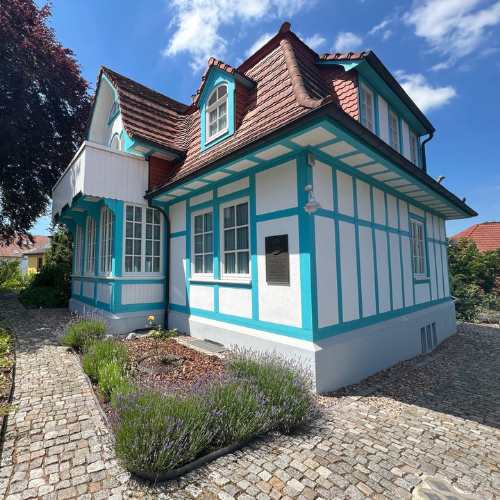Why is the holiday apartment called “Blaue Blume”?
The Blaue Blume (Blue Flower) represents longing and love. My grandparents bought and moved into the beautiful half-timbered house in 1942 and lived there until their escape from the East in 1952. My father was 11 years old at the time and experienced the escape as a very traumatic event. On the island of Borkum, my father met his “Blaue Blume,” my mother, the love of his life. In 1989, when I was 11 years old, the Berlin Wall fell, and my father showed us his birthplace, Eisenach, for the first time. Over the years, my family moved entirely to Eisenach. As an architect, my father spent over two years meticulously restoring the half-timbered house with great attention to detail, as it was also a “Blaue Blume” for him.

History of the House
The Beginnings 1914 – From the Gymnasium of the Girls’ Boarding School to a Chicken Coop
The house was built in 1914 by architect and master carpenter Arno Gunkel as an annex for the girls’ boarding school across the street. In the space now occupied by the holiday apartment was the gymnasium for the young ladies. After World War I, the girls’ boarding school was dissolved, the half-timbered house was sold, and it was used as a residential property. According to all later residents, however, the gymnasium had an “awkward size” for any other use. Thus, it became a popular play area for the children of the neighbourhood during bad weather. It was filled with old furniture, boxes, boards, and even a chicken coop found its place there.
The War Years & End of the War – Dental Practice
Over the years, the house changed ownership several times. On April 1, 1942, it was purchased for 32,000 Reichsmarks by my paternal grandparents. My grandmother had wisely anticipated the future and had already moved my grandfather’s dental practice from the city to the house at Wernickstraße 7 in the summer of 1944. Towards the end of the war, a shell struck the previous practice in the city. Aside from shattered windows (with two exceptions), the half-timbered house fortunately escaped major damage. After a brief American captivity, my grandfather resumed his dental practice here at Wernickstraße 7. During power outages, a foot-operated drill was used, which likely left some former visitors with painful memories of this house.
The Early Post-War Years – “Which Idiot Built This House?”
In the summer of 1945, the house nearly was requisitioned by a Soviet officer, but my grandmother managed to move most of the furniture to the coal cellar in time and intentionally guided the Russian officer, interpreter, and German liaison through the sparsely furnished house via oddly convoluted paths. First, they went up the stairs, through a room, up the attic stairs, then back down, out onto the terrace, past the hall, down a few steps to the landing of the gymnasium, and then down more steps… The irritated Russian officer quickly departed with the remark: “Which idiot built this house?” Thus, the requisition was averted. According to my father’s stories, roaring carnival parties took place in the family home in the following years until their escape from East Germany. Every year, extensive work and painting were done in preparation, including once building a slide in the stairwell. The attic was transformed into a heaven, the slide led to the ground, and from there further into the air-raid shelter, into hell.
The Years of DDR Dictatorship – The Decline of the House
After my grandparents and their two children left “the territory of the GDR without adhering to police registration requirements” in the summer of 1952, the house was taken over by the city’s administration. The authorities sold furniture, household goods, and other items for 4,771.45 Marks, and the property was nationalised on April 24, 1953. Until the early 1970s, the house frequently changed occupants. From 1971/1972 onwards, a major and a captain of the border troops with their families occupied each floor. Over the years, renovations took place in the house, including the transformation of the once large hall into five small rooms. There was already a need for renovation during and after the war. By the late 1980s, the house was in an unacceptably dilapidated state.
The Years Since Reunification – Goodbye to Gloom!
In 1990, my father, Arnd Kniese, applied for restitution, which was granted on October 2, 1992. The extensive and costly renovation of the half-timbered house took two years and, from a commercial perspective, was, to put it mildly, “nonsense,” according to my father. As an architect, my father placed great importance on an as-faithful-to-original-as-possible restoration. Some changes were made, of course, including improved thermal insulation, and the likely originally light gray beams and ochre-yellow panels were transformed into lively light blue beams and white panels. From then on, it was and still is: Goodbye to gloom! Since 1996, the charming half-timbered house has been classified as an urban-scientific cultural monument.
2024 – From the Former Gymnasium and Chicken Coop to a Holiday Apartment
My parents initially converted the gymnasium into an apartment. For the first few years, it served as a place for friends and family to stay overnight, before being increasingly used as a storage room from the 2020s – until the summer of 2023. I decided to make my early childhood dream a reality. In my spare time, I cleared out the apartment, replaced lamps, pictures, door handles, smoke detectors, and much more, had the kitchen completely renewed, and made changes to the garden as well. It hasn’t become a B&B in a cottage in Scotland, but rather a charming holiday apartment in the picturesque southern district of Eisenach.
Ultimately, it took 110 years to find a very beautiful and meaningful use for the “gymnasium” with the “awkward size.”
